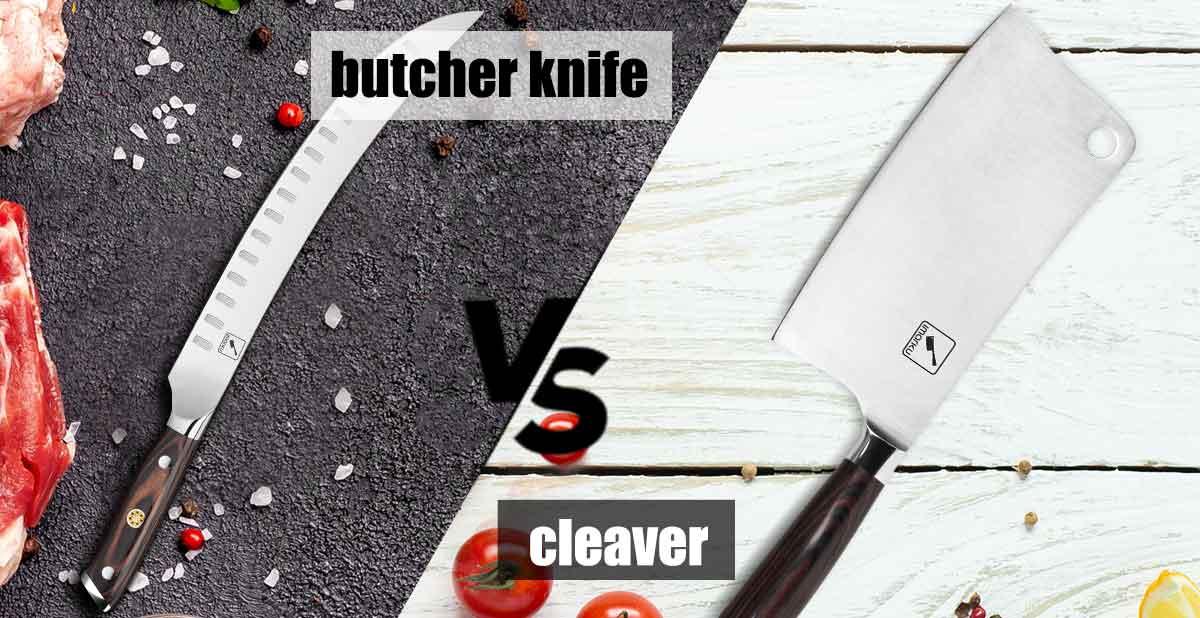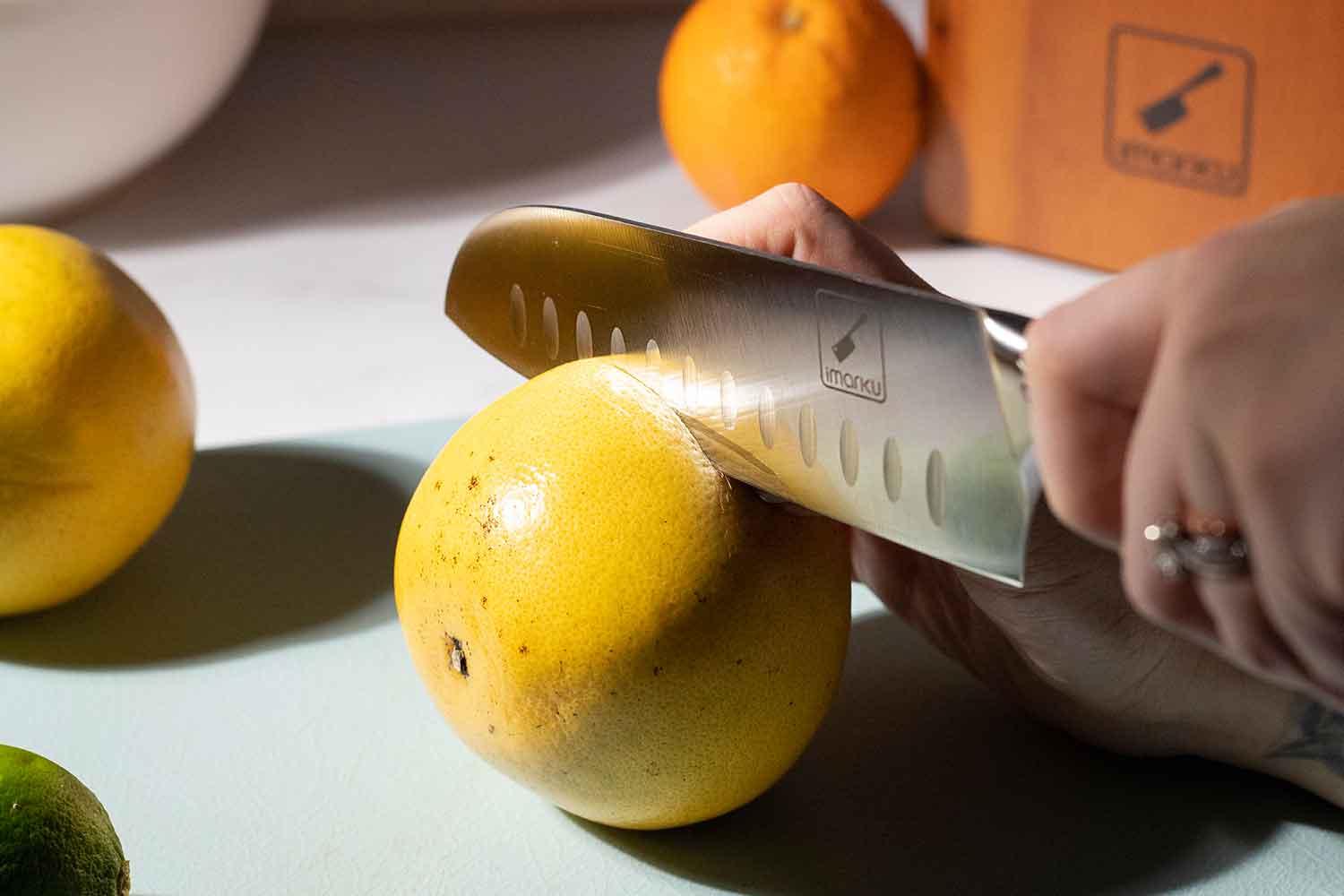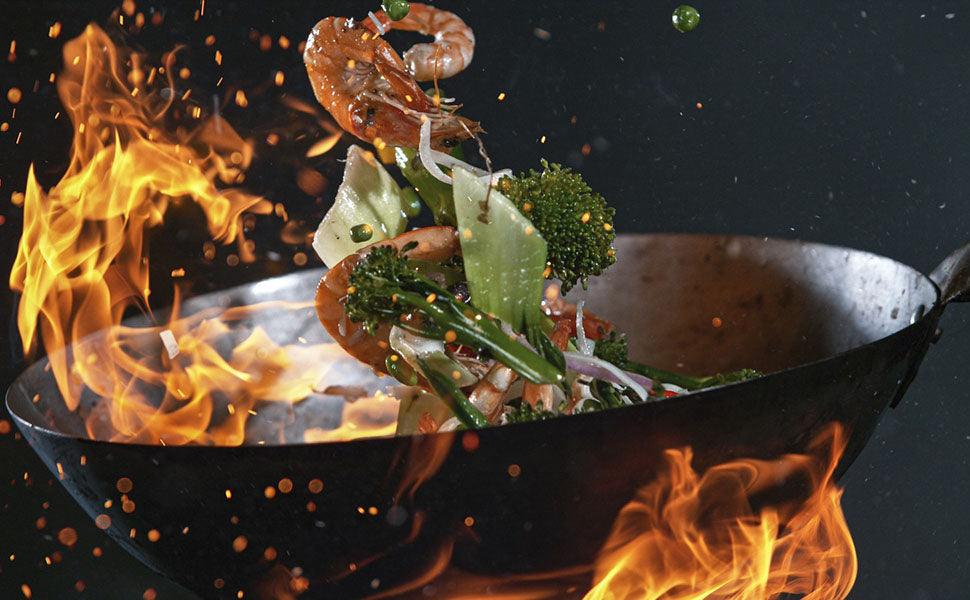TABLE OF CONTENTS
Whether it's for home use or a professional environment, butcher knives and cleavers are among the most popular knives in the kitchen. They are normally used to cut, split, and even strip the meat from bones. While their functionalities may appear similar, they are different in terms of design. So, what's the difference between a butcher knife and a cleaver?
What's a Butcher Knife?
It's a popular blade cutter that's used to dress or butcher pieces of meat. It effectively breaks down large meat pieces into smaller, manageable slices. Besides that, it's effective in slicing off fat from meat.

What's a Cleaver?
It's a bold, heavy, and large bone chopper used to hack through simple and complex bones, cut through connective tissues and break down any type of meat.

The Uses of a Butcher Knife
Cleaving meat out of the bone
Ideal for dressing and prepping raw meat
Good for in-bone, thick and tough cuts
If you need to cut a large chunk of meat into smaller pieces like retail-sized, this is the most suitable option. If you are looking for a butch knife set, read this first:
How to Choose The Best Butcher Knife Set.
The Uses of a Cleaver
Best fit for all sorts of meat preparation
Helps in cleaner and more precise cuts
Normally cut through simple and complex animal meat and bones.
Butcher Knife vs Cleaver Knife: Comparison Overview
Butcher knives and cleaver knives are the ultimate kitchen knives for meat lovers. They get the work done in the kitchen. But sometimes, it can be quite challenging to determine the type of cutter you should have in your kitchen. Which one should you choose between a cleaver and butcher knife? Several design features make them different, including:
Curious about why there is a hole in a meat cleaver, check out the reason for it.
| Feature | Cleaver | Butcher Knife |
|---|---|---|
| Weight | Cleavers: Heavier, might need more effort. Up to 2.5 lbs. | Butcher knives: Lighter, easy handling. Vary in weight. |
| Blade Size | Cleavers: Sturdy, 6-8 inches. | Butcher knives: Versatile, 6-14 inches. Great for various cuts. |
| Sharpness | Cleavers: Effortless bone cutting. | Butcher knives: Simple bones, separate flesh, some bone limits. |
| Blade Thickness | Cleavers: Thick blades, 0.25 to 0.75 inches. | Butcher knives: Thicker than standard, 0.35-0.45 mm. |
1.Weight
Weight is important for comfortability and ease of use. Of course, both are heavyweights since they are strong knives for cutting purposes. But there is a distinct difference between them. Consider this:
A cleaver's weight usually corresponds to the height and length of its blade. The longer the blade and the higher the height, then the heavier the cleaver. However, you must be ready to use more strength when using a heavier cleaver since some of these cutters can weigh up to 2.5 pounds.
On the other hand, the size of the butcher knife will determine its weight. Smaller knives are lightweight, and the converse is also true. However, butcher knives are generally lightweight compared to cleavers.
Take a look at this. An 8-inch blade cleaver weighs around 3 pounds, while an 8-inch blade butcher knife weighs around 2.5 ounces. If you constantly deal with heavy pieces of meat, then you should still consider a heavier type of knife.
2. Blade Size
There is a direct relationship between weight and the size of the blade. When comparing a cleaver to a butcher knife, one thing that stands out is that they both have thicker blades than the standard kitchen knife. Well, this is because they are designed to handle chunks of meat as well as fat.
Cleavers are generally heavy with a thick blade and a rectangular shape. The blade size is available in a wide range. This is because everyone has their unique size preferences. It depends on their arms' length and how frequently they intend to use the cleaver. Generally, cleavers have blades measuring 6-8 inches long.
Butcher knives offer more choice options when it comes to blade length. This is because it's a versatile option that can be used for basic meat chops, preparing delicate fillets, and even handling big bones. The fact that you can use this knife to handle meat with complex muscles and juicy soft meat means that you should consider the size. Generally, they are available in 6-14 inches.
While there are several blade inches of both butcher knives and cleavers to choose them, the choice is yours. Go for what will fit your hand and make you comfortable while using the minimal effort possible.
3. Sharpness
Understand that your cleaver or butcher knife won't give you the desired results when the blade is extremely thick or too thin. However, the design structure of all kitchen cutters requires a certain level of sharpness so that some weight can be applied behind the blade without you straining so much.
Sharpness is critical in slicing through meat or cutting bones. When comparing a cleaver vs butcher knife, only one of them has been specifically designed with a level of sharpness that makes it possible to easily go through bones. Well, that's a cleaver.
If you are looking for a kitchen tool that guarantees you better bone cutting, you should consider getting a cleaver. This is the lead champion when it comes to the top bone cutters. The heavy-duty device easily goes through bones without the need to apply extreme force. Just make sure that you choose a comfortable cleaver that's durable and sturdy enough.
On the other hand, a butcher knife is used when dealing with simple bones such as those belonging to poultry. Besides that, the usefulness of this knife is only restricted to separating bones and flesh, which makes it difficult for you to cut through bones. However, this knife can still do a good job if you need small bone chops without complex structures.

4. Blade Thickness
Weight and thickness go hand in hand. The lighter the knife or cleaver, the thinner its blade. Since both the cleaver and butcher knife have been made to enhance the efficiency of cutting through meat, they all have a reasonable level of thickness. Compared to the standard kitchen knife, you will notice that they have the thickest blades. But how thick are they, and what makes the design of their blade thickness different?
A cleaver's blade is generally thick. However, its design means that the thickest part usually starts from the cutting edge to the spine. This feature is critical in influencing the cutting angle. As a result, a cleaver can be used to cut through slim and wider angles since its degree of operation is wide. Heavy bones will need chunkier blades, while the vice-versa is also true. Cleavers' blade thickness range is 0.25 to 0.75 inches.
On the other hand, a butcher knife is thicker than a normal kitchen knife. However, it's not thicker than the cleaver's blade. Its thickness also depends on the height of the blade. Since it's a carving knife, the best blade thickness is around 0.35 mm, but you can also pick up to 0.45 mm.
When looking at the blade thickness, ensure that you pick a knife or cleaver that feels comfortable in your hands and gives you the ultimate control.
Type of Butcher Knife/Cleavers
There are several types of cleavers and butcher knives. So, the type you end up choosing depends on your personal preferences, especially what you frequently intend to use the kitchen tool for.
Type of Butcher Knife
• The traditional butcher knife: designed with a wide and curved tip. Ideal for cutting and butchering large meat cuts. Besides that, it's ideal for skinning large animals.
• The skinning knife: It's specifically made for skin animals. This butcher knife has a wide blade that normally curves upward for an enhanced cutting motion.
• Boning knife: used to remove flesh from fish bones and meat. It can be curved, stiff, straight, or flexible.
• The cimeter knife: has a long and curved blade. The large butcher knife is ideal for cutting large pieces of meat, and that's why it's popularly used in retail areas.
Types of Cleavers
• The meat cleaver: it's made with a large and broad blade. It's one of the most prominent butcher knives since it looks like a hatchet. It's ideal for cutting cartilage, splitting bones, and cutting through large meat pieces. With its iconic blade hole, the meat cleaver can efficiently chop through joints, bones, and frozen foods.
• Vegetable cleaver: it's also known as the Chinese cleaver. Its profile is thinner, and this makes it ideal for chopping through delicate food. It's ideal for mincing, slicing, as well as chopping boneless meats, vegetables, and fruits.
Cleaver vs Butcher Knife FAQs
Q: Is there Any Physical Difference Between a Butcher Knife and a Cleaver?
A: Yes. A cleaver is a type of large knife with varying shapes. But it generally looks like a classic rectangular-shaped hatchet. Meanwhile, a butcher knife is thicker than a standard kitchen knife. It's similar to a scimitar or cimeter with a long and broad curved blade. Note that a butcher knife's blade usually tapers to form a razor-sharp tip.
Q: Which Type of Knife is Best to Cut Through Bones?
A: It also depends on the type of food you are handling. These two knives are thicker and more efficient than standard knives, and they are, therefore, ideal for cutting through bones. However, if you are dealing with simple bones such as birds like chickens, then a butcher knife can come in handy. But if you are dealing with complex bones, especially those that involve big joints, then you should consider using a cleaver.
Q: How Can these Knives be Stored?
A: A butcher knife can be stored just like any other standard kitchen knife. You can mount it on a wall that has a magnetic strip. Alternatively, you can store it on the kitchen counter as long as the place is cool and dry. A drawer dock or under the cabinet would still be ideal for storage as well.
A meat cleaver has a hole drilled on its end, and this can be used for storage purposes. You can simply hang your knife on any hook for easy access. Alternatively, you can also use a magnetic strip designed for heavy cleavers.
Note: a butcher knife can also have that hole, but its main purpose is to eliminate the formation of a vacuum when the blade is cutting through food or meat. This helps to enhance back and forth motion since you can always move or pull out the knife easily.
Q: Is Sharpness Important in Determining the Effectiveness of a Cleaver or Butcher Knife?
A: For any device that's used for cutting, sharpness is important. Both the cleaver and butcher knife are meat to go through meat and bones. This means that a blunt blade will require the use of more force. Razor-sharp cutters are usually easy to use, and they guarantee users more efficiency. However, make sure that you consider the thickness of the blade as well since a sharp knife and a thinner blade would still be inefficient for chopping meat and cutting bones.
Q: What Makes a Good Cleaver/ Butcher Knife?
A: It all depends on what you want. But generally, the design features such as blade thickness, type of handle, weight, blade material, and durability are critical factors that make a good butcher knife/ cleaver. The goal is to find something that gets the job done and feels comfortable in your hand.
Cleaver vs Butcher Knife: Which Knife is the Best?
From the above comparison review, it's clear that cleavers and butcher knives are quite different. It's not possible to outrightly state the best between the two since they have different functionalities.Overall, the best knife depends on what you need and can afford. If you are working with smaller meat cuts with simple bone structures, you should consider getting a butcher knife. In case you need a skeleton-crushing cutter that leaves no bone unturned regardless of its complexity, then a cleaver would be an ideal option. The goal is to get a cutter that offers better agility, comfort, and control. Butcher knife vs cleaver, do you know which one is the best?






















Leave a comment
All comments are moderated before being published.
This site is protected by hCaptcha and the hCaptcha Privacy Policy and Terms of Service apply.